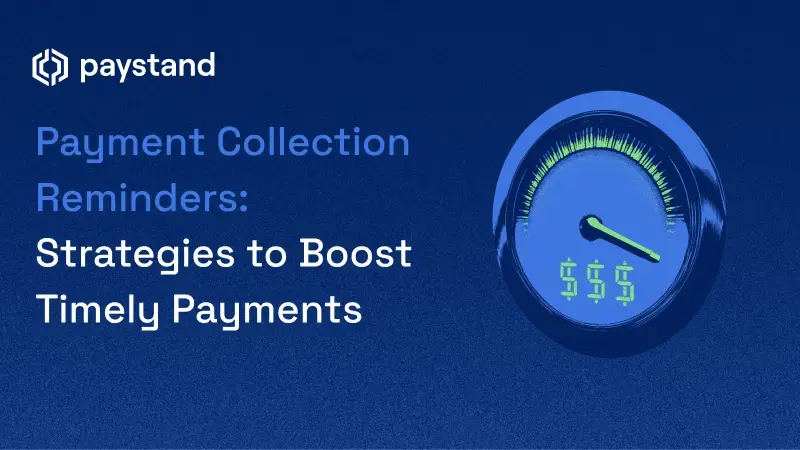Payment Collection Reminders: Strategies to Boost Timely Payments

Table of Contents
- What Are Payment Collection Reminders and Why Do They Matter?
- How to Schedule Reminders for Maximum Effectiveness
- Crafting a Powerful Payment Reminder Message
- Best Practices for Payment Reminder Automation
- Reliable Payment Reminder Automation Systems: Features to Look For
- Streamline Payment Collections with Automation
- Automate to Accelerate with Paystand
Key Takeaways
- Payment collection reminders are critical for maintaining healthy cash flow and ensuring invoices don’t fall through the cracks.
- Automated reminders improve collection rates by reducing manual follow-ups and ensuring consistent communication.
- Automation helps small teams scale collections efforts without overburdening staff or risking errors.
- The right cadence of reminders—before, on, and after the due date—encourages timely payments while preserving client relationships.
Late payments hurt cash flow, strain vendor relationships, and require additional resources to chase unpaid invoices. Payment collection reminders are an excellent tool for collection management in a B2B company. Their function is to ensure quick payment collection, guaranteeing good cash flow.
This guide will show you how to use reminders effectively, including how to automate payment reminders, choose the right tools, and craft messages that improve results.
What Are Payment Collection Reminders and Why Do They Matter?
A payment collection reminder is a message sent to a customer when an invoice is due or overdue. It can be as simple as an email or as proactive as a scheduled phone call. These reminders are a vital part of your accounts receivable process because they:
- Encourage timely payments
- Reduce Days Sales Outstanding (DSO)
- Minimize follow-up workload
- Preserve cash flow and working capital
Used correctly, these messages become a friendly nudge—not a confrontation.
How Does Automation for Payment Reminders Help Improve Collection Rates?
Manual reminders are time-consuming and often inconsistent. Automating your reminder workflow has been proven to improve collection rates by 20–30% for many businesses.
Here’s how:
- Real-time triggers: Automated systems detect when an invoice is issued, due, or overdue and send reminders instantly—no delays, no human error.
- Consistency: Customers receive a predictable cadence of reminders that reinforce your payment terms.
- Scalability: As your AR volume grows, automation ensures your team doesn't get bogged down with repetitive tasks.
When you automate payment reminders, your team focuses on high-touch escalations, not manual follow-ups.
How to Schedule Reminders for Maximum Effectiveness
It may seem simple, but payment reminders must follow guidelines to reach a reasonable resolution. They're an essential part of a more comprehensive collection strategy and are critical in maintaining healthy cash flow for businesses.
However, balancing persistent follow-ups and respecting the customer's privacy is important. Getting the timing right is crucial. Here's a typical schedule that balances professionalism with persistence:
First reminder
7 days before due date: A gentle heads-up.
“Just a reminder: Your invoice is due soon.”
These reminders should use a cordial notice reminding customers of the due period. The message must differ from any claim since customers still have time to pay. It's designed to prevent non-payment due to forgetfulness, so a friendly treatment is recommended.
Second reminder
On the due date: A firm but friendly prompt to take action
“Your invoice is due today.”
These reminders should follow the same tone as the first one sent out. Avoid making any claim since the customer is not yet delinquent.
Third reminder
3 days after due date: After no news of any kind has been received from the customer, send out a more urgent message with a link to pay.
"Your invoice is now past due. Please complete your payment at your earliest convenience."
The words for this message should express firmness and clarity in claiming the outstanding invoices.
Forth reminder
7–14 days overdue: Escalate tone and offer support or payment options.
"This invoice is one week overdue. You need to pay immediately. Let us know if you need payment options or assistance."
It can include the consequences of non-payment: from legal action to more serious business decisions, such as late payment penalties, disruption of services, or even the suspension of future business engagements—all in accordance with the agreed-upon payment terms and applicable laws.
Fifth (and final) reminder
30+ days overdue: Consider a phone call or involve the collections team.
"This is a final reminder. If payment is not received, we may take further action."
Use these intervals as a starting point, then adjust based on customer behavior and payment history.
Crafting a Powerful Payment Reminder Message
Your payment reminder message should be professional, clear, and easy to act on. Use the following structure:
- Greeting: Friendly and polite
- Invoice details: Include invoice number, due date, amount, and payment terms
- Payment link or instructions: Make it easy to act
- Support offer: Provide contact info for questions
- Thank you: Reinforce a positive tone
Example:
Subject: Reminder – Invoice #45678 is Due
Hi [Name],
This is a friendly reminder that Invoice #45678 for $1,200 is due on [Date]. You can view and pay the invoice using the link below.
[Pay Now]
If you have any questions or need assistance, just reply to this email. Thank you!
—The [Your Company] Team
Using payment reminder templates helps ensure consistency and saves time—especially when automated.
Best Practices for Payment Reminder Automation
To get the most from your system, follow these steps:
Personalize Where Possible
Even automated reminders should feel human. Add first names, specific invoice numbers, and a friendly tone.
Offer Multiple Payment Options
Whether it’s ACH, credit card, or digital wallet, giving your customers flexibility makes it easier for them to pay on time.
Use Multiple Channels
Don’t rely on just email. Combine emails with SMS, phone calls, or even in-platform messages (if using portals like Paystand) to increase visibility.
Align With Payment Terms
Ensure your reminders reinforce agreed-upon payment terms. Include these in the message for clarity and record-keeping.
Reliable Payment Reminder Automation Systems: Features to Look For
When evaluating your options, prioritize tools that offer:
- Template customization for different customer segments
- Schedule flexibility to align with your workflow
- Analytics dashboards to monitor open and click rates
- Integration with your ERP
- Secure payment links for immediate action
- Role-based access and audit trails for compliance
A cost-effective automated payment reminder tool should pay for itself quickly by reducing overdue invoices and freeing up internal resources.
Streamline Payment Collections with Automation
Still chasing invoices manually? You're not alone—but there’s a smarter way.
For many finance teams, this is one of their top Accounts Receivable challenges, especially in small and mid-sized businesses. This manual approach isn’t just time-consuming—it’s unsustainable.
Automating payment reminders offers a powerful alternative. It allows you and your team to:
- Send polite, timely payment reminder messages at scale
- Improve your payment collection rates without constant follow-ups
- Reduce errors and avoid letting invoices slip through the cracks
- Maintain professional, non-confrontational communication with customers
For small teams, automation doesn’t just save time—it preserves energy. You can scale your collections efforts and ensure timely payments without burning out your existing staff or pulling resources away from higher-value work.
Automate to Accelerate with Paystand
Payment collection reminders are essential to a healthy cash flow strategy, but doing them manually is no longer sustainable. Automating payment reminders streamlines your process, allows you to get paid faster, and frees your team to focus on what matters most.
Whether you're a small business owner or a mid-market finance leader, investing in the right tools, templates, and workflows can drastically improve your collections performance.
Paystand is a B2B platform that leverages blockchain technology and a user-friendly interface to allow quicker, more effective, and more secure transactions. It helps manage invoices, automate payment reminders, provide various payment methods, reduce per-transaction fees, accelerate cash flow, reconcile payments, and more. Overall, Paystand helps you achieve improved and more efficient AR management.
While many solutions focus narrowly on collections, Paystand goes further, offering a full-scale, fee-less B2B payments infrastructure that eliminates manual work and improves cash flow. If you’re exploring your options, our free guide, How to Choose the Best AR Software, walks you through what to look for, how to evaluate tools effectively, and why Paystand stands out as more than just another collections platform.





